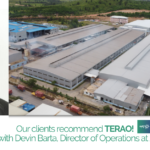HQE

TERAO intervenes as HQE AMO, HQE BE, HQE BET, HQE Auditor. We carry out HQE™ certification support from the Feasibility and Environmental Programming phase, through Design, Construction and Commissioning, to Delivery and Operational Monitoring.
For TERAO, certification is a virtuous process that catalyzes, frames and guarantees the achievement of high environmental performance objectives. However, we do not consider standards as an end in itself but as a means, and we make sure that they are the vectors of a greater intelligence of the Projects, by privileging profiles and useful and shared environmental and technical-economic trade-offs in the service of the global objectives of our Customers.
The “HQE™ Bâtiment Durable” certification was released in 2016 and succeeds the “NF HQE™ Bâtiments tertiaires en Construction ou en Rénovation” standard that has existed since 2006. It applies to a very wide variety of tertiary buildings. This High Environmental Quality Building certification is generalist and multi-criteria.
THE 14 TARGETS OF HQE™ (TO HQE™ TERTIARY BUILDINGS 2015)

ECO-CONSTRUCTION
- relationship of the building with its immediate environment
- integrated choice of products, systems and construction processes
- low environmental impact construction site

ECOGESTION
4. energy management
5. water management
6. activity waste management
7. maintenance – sustainability of environmental performance

COMFORT
8. hygrothermal comfort
9. acoustic comfort
10. visual comfort
11. olfactory comfort

HEALTH
12. sanitary quality of spaces
13. sanitary quality of the air
14. sanitary quality of water
The HQE™ certification for tertiary buildings also applies in operation (“NF HQE™ Tertiary Buildings in Operation” certification). This certification is based on a technical reference system in two parts: The SMO (Operation Management System)
The EQB (Environmental Quality of the Building)
The HQE™ certification postulates in particular that the Environmental Programming of the Building must be based on a relevant Site Analysis, and that the Management of the Operation, i.e. the involvement and the rigorous identification of the responsibilities of each actor of the projects, is a fundamental condition to define and reach ambitious objectives.
Advantages of HQE
A demanding but qualitative and contextual approach
The Environmental Management System provides leverage on the organizational dimension of projects
HQE™ gives an important part in the health and comfort of users (50/50 with the Environment)
Flexibility to reach the TP levels (means requirements)
HQE™ SUSTAINABLE BUILDING

Complete overhaul of the standard: 4 commitments (Quality of life, Respect for the environment, Economic performance
Performance, Responsible Management), translated into 12 objectives
Introduction of territorial impacts & a detailed analysis of the building’s overall cost, CSR & responsible management
management, biodiversity, mobility, circular economy
The prerequisites correspond to the regulatory requirements
Disadvantages of HQE
Complexity of the scope of application (programmatic entities)
Applicability of requirements sometimes subject to interpretation
Complexity of the HQE™ Sustainable Building 2016 rating system
High administrative costs
HQE™ Sustainable Building 2016 requires additional studies compared to HQE™ 2015

![[Expertise] How to conduct an energy audit to identify areas of energy waste in business](https://teraoasia.com/wp-content/uploads/2024/06/Expertise-1-150x150.jpg)
